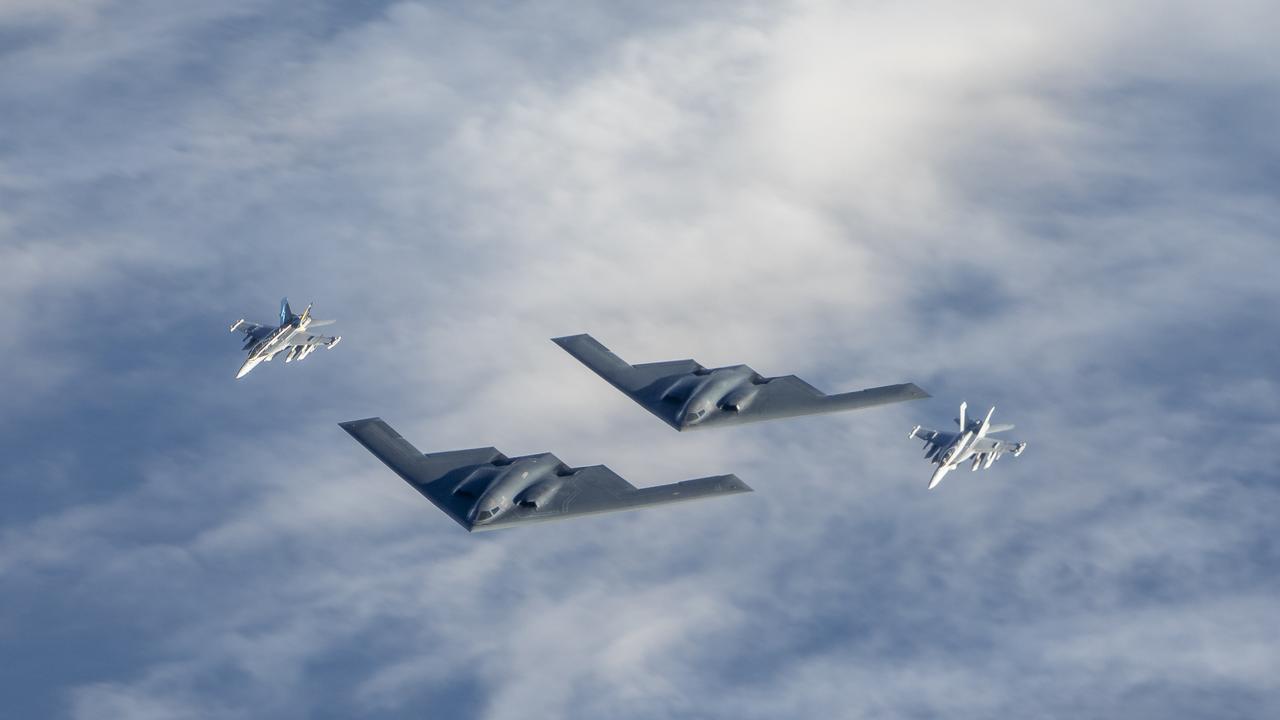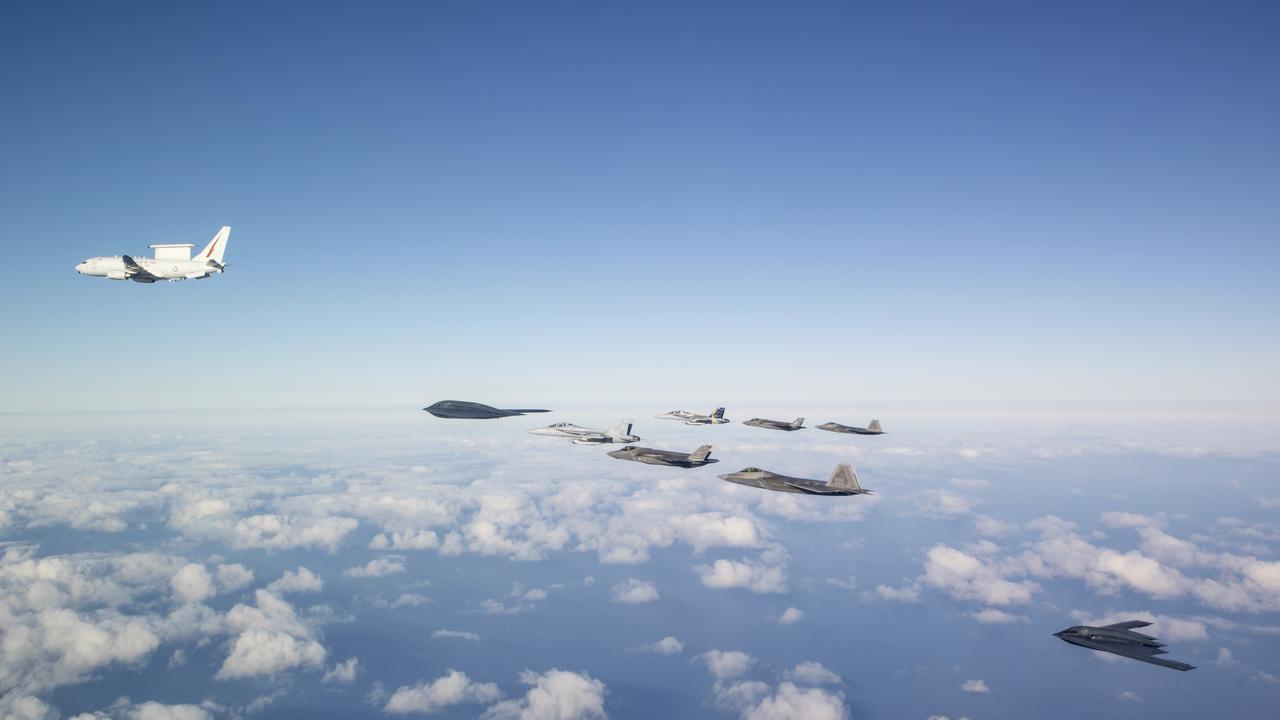‘Rapidly deteriorating’: Disturbing sight spotted over Australian skies
A grim sight appeared “out of nowhere” over Australian skies recently – and it reveals a chilling, “rapidly deteriorating” situation.

A bird of ill omen is in the skies over Australia. Three black, bat-shaped US B-2 Spirit stealth bombers have made a surprise visit Down Under. And they’re here because of rapidly deteriorating relations with China.
The United States air force stealth bombers appeared out of nowhere at Royal Australian Air Force Base Amberley in Queensland last month. They’ve since taken to Australian skies in a series of joint exercises.
The US Defence Department says the mission was to demonstrate its “credible bomber force that enhances security and stability of our allies and partners”.
The nuclear-capable stealth aircraft were last in Australia in 2022. But increasing tensions between China, India, Japan, Taiwan and the Philippines have prompted the US air force to up the tempo of its training operations in the region.
Two of the B-2s have been engaging in flight operations with the RAAF. Two RAAF F-35A Lightning stealth fighters, two EA-18G Growler electronic warfare aircraft and an E-7A Wedgetail radar aircraft were joined by USAF F-22 Raptor fighters in the air over southeastern Australia.
All were refuelled by Australia KC-30A tankers.
A third B-2 crossed the country and flew 5300km deep into the Indian Ocean to make a “hot pitting” stop at the remote US-controlled island of Diego Garcia.
“This deployment is in support of Pacific Air Forces’ training efforts with allies, partners, and joint forces and strategic deterrence missions to reinforce the rules-based international order,” a statement from the US Pacific air force Command (PACAF) said.
Bomber task force
“Bomber missions contribute to joint force lethality and deter aggression in the Indo-Pacific by demonstrating the US Air Force’s ability to operate anywhere in the world at any time,” a PACAF statement reads.
The aircraft from the US Air Force’s 509th Bomb Wing and 131st Bomb Wing flew the 13,750km from Whiteman air force Base in Missouri to Queensland on August 16.
The two-seat B-2 Spirit first entered service in 1989.
It’s believed to be the most expensive aircraft ever built, with an estimated price tag of $US2 billion ($A3 billion) each.

It has since proven to be incredibly difficult to maintain.
The US air force operates only 19 B-2s. About half are in service at any one time.
The Bomber Task Force missions that fly out of Guam and Diego Garcia generally consist of 69-year-old B-52 Stratofortress long-range heavy bombers alongside a handful of 1980s vintage B-1 Lancer strike bombers.
But the B-2 remains the US’s most capable aircraft until a new generation of cheaper, more standardised B-21 Raider stealth bombers enters service.
The B-2 flight to Diego Garcia was to practice rapid deployment and turnaround for the complex aircraft.
“Hot pitting” is when an aircraft lands, refuels, changes crew and takes off without shutting its engines down.
“If we lose a tanker or don’t get a tanker for aerial refuelling, a hot pit enables us to move our jet from location to location, refuel and complete the mission,” the B-2’s pilot said in a PACAF statement.
US military planners are seeking to broaden the range of options across the Indo-Pacific from where it can operate its aircraft amid China’s increasingly aggressive moves against India, Japan, Taiwan and the Philippines.

Any conflict with Beijing would likely see US bases on Guam and the Japanese island of Okinawa heavily attacked by missiles. As a result, the US air force is rebuilding its capacity to quickly establish and operate out of “austere field” positions as it did in the Pacific during World War II.
Tense times
“We’re increasing the presence of rotational US forces in Australia,” US Secretary of Defence Lloyd Austin said just a week before the surprise deployment.
“All this will mean more maritime patrol aircraft and reconnaissance aircraft operating from bases across northern Australia. It will also mean more frequent rotational bomber deployments.”
USAF Bomber Task Force missions generally last about a fortnight. The idea is to ensure allies and facilities gain experience in operating the notoriously fragile 30-year-old behemoths.
The B-2 Spirits are just the latest demonstration of US muscle flexing.

Just weeks earlier, USAF F-22 Raptor stealth fighters conducted a similar rapid deployment test to Indonesia, Brunei and the Philippines – all nations bordering the contested South China Sea.
And in June, B-2 Spirits appeared alongside B-1 Lancer bombers at the upgraded US base on the mid-Pacific island of Guam for the first time in five years.
But the US is providing a $US450 million ($A665 million) upgrade of Australian facilities at the RAAF Tindal air force base in the Northern Territory. Tenders have been issued to extend the concrete parking aprons, fuelling and maintenance capabilities to accommodate up to six B-52 Stratofortress bombers and their support aircraft.
“What this is doing is allowing us to do a much greater range of activities and operations and exercises with our partners,” Minister for Defence Richard Marles said alongside Secretary Austin.
“With Japan, for example, where we’ve committed to doing a much greater amount of trilateral exercises between our three countries, but also doing more maritime domain awareness work, not only with Japan, but with the Philippines and with India.”
Defence Minister Marles also confirmed the US would be establishing a Submarine Rotational Force in Perth to maintain forward-deployed nuclear-powered attack submarines.
And the US is building a new logistics base at the Bandiana Military Area near Albury on the Victoria-NSW border.
Originally published as ‘Rapidly deteriorating’: Disturbing sight spotted over Australian skies





